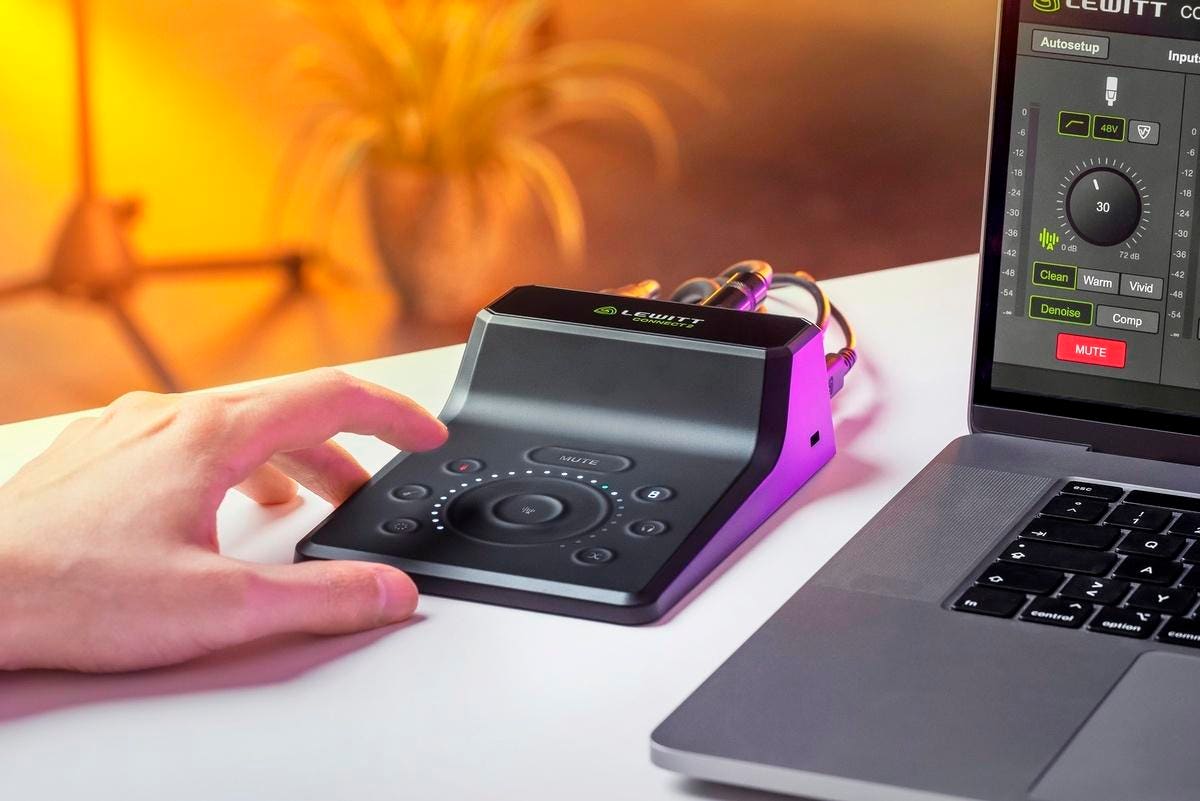The Connect 2 from Lewitt Audio is a compact USB audio interface with a unique and select touch … [+]
Sometimes a product comes along that seems really innovative and fresh. The Lewitt Connect 2 is just such a product. This USB audio interface from the Austrian-based brand is making serious waves thanks to its easy-to-use features and excellent companion software.
Connect 2 is a compact and affordable audio interface with XLR input for microphone and Hi-Z input for keyboard or guitar. The interface has most of the tools you need to capture voices and instruments, making it ideal for recording at home and creating sound effects, even on the go.
Connect 2’s touch-sensitive surface is intuitive and easy to use. The controls are silent, so there are no annoying clicks that can be picked up by the microphone. The main control is a large wheel surrounded by sensors for setting input levels, gain, monitor output, headphone volume, and mixing the sound coming from the host computer with the inputs.
On the back of the Connect 2 are all the inputs and outputs you need to connect an XLR microphone and … [+]
The Connect 2 also features a prominent and silent MUTE button that can turn everything off or mute individual inputs or outputs. Finally, there is a dedicated function button that can be programmed with a selection of actions such as toggling preamp settings or bringing the Control Center software to the fore.
The interface is about the size of a small notebook and small enough to put in a bag to take on the go. It comes with a slightly thin USB cable that draws the power needed to run the interface from the host device, be it a PC, phone or tablet.
At the back of the Connect 2 are the inputs and outputs, including a single XLR socket with a 48V switch for phantom power to drive condenser microphones. For connecting an instrument there is a Hi-Z 6.3 mm jack. Next to it are two mono 6.3mm jacks for outputting audio to a pair of active speakers. There’s also a choice of 6.3mm and 3.5mm stereo jacks for monitoring headphones, plus a USB Type C port for connecting the Connect 2 to a host computer.
The touch-sensitive control surface of the Connect 2 control panel is intuitive and … [+]
So, that’s the basic technical stuff and it all sounds pretty simple so far. But what makes the Lewitt Connect 2 special is its software. This is the secret sauce of Connect 2. The Connect software is superbly polished with most of the controls needed to ensure the best results.
The XLR mic section has a gain knob to adjust the mic level. There’s also a low-pass filter to filter out rubs and low frequencies, a 48V phantom power option, and something called Clipguard, which works as a limiter and does a great job of stopping the audio from veering off into clipping.
Below the gain knob are three preamp settings for Clean, Warm and Vivid EQ. The Warm setting is a bit woolly, but has a nice rich FM sound. The Clean setting does what it says on the tin, while the Vivid setting is so crisp and sharp it’ll make you sit up straight and speak properly.
Connect 2 is the perfect interface for recording on the go or in a quiet corner. It has … [+]
There are two more settings for each channel. The first is a Denoise control. Click this button and sit in silence while Connect 2 samples the room noise for 10 seconds. The result is a sharp drop-off muffler that does a superb job of cutting out unwanted sounds like the hum of a refrigerator or the hum of an HVAC unit.
The final control is a compressor. There are no fixes or settings for this. It’s a binary control that boosts quiet sounds and tames excessive ones. It’s a bit primitive, but it works.
The instrument section duplicates most of the same microphone settings, with the exception of the Clipguard. What you don’t get is any kind of Reverb or other settings that sculpt the sound, although there are Clean, Warm and Vivid preamp settings. It’s not a big deal and you can always add special effects using a plugin through your DAW.
Control Center software is the secret sauce of CONNECT 2. It’s easy to use and has tools that work … [+]
Although the Connect 2 has professional sound with sampling that goes up to 96kHz, it’s an easy-to-use interface. The Autogain function can set the levels for both channels, while the Autotune takes you through the ideal settings for Clipguard, Denoiser, Compressor and three preamp modes.
There are plenty of LEDs to show the status of all buttons, gain levels, headphone volume and monitor outputs. The LEDs can be fully customized with a choice of colors and adjustable brightness levels. There are other customization options, such as a high-impedance output for working with difficult headphones.
Like all USB audio interfaces, Connect 2 provides zero-latency monitoring through headphones. You can sing along with pre-recorded material or overdub an instrument or whatever else you want to record on your DAW. You can even use the Zoom call audio interface, which makes your audio sound much better than using a laptop’s built-in microphone.
The Autogain function can set the ideal level. Turn on Clipguard to make sure you hear sudden loud sounds … [+]
The Loopback channel allows you to send the computer signal back as the audio processing is done by the DSP in Connect 2, running independently of the DAW running on the host computer. It’s perfect for streaming and recording samples. With available input channel mapping options and dedicated streaming mode, you can connect the 2 to your streaming software, mobile devices and mobile apps.
The sound produced by the Connect 2 is impeccable. With 72 dB of gain, there is plenty of headroom and the noise level is low. The unit can handle even the most reluctant microphones, such as Shure’s notoriously difficult SM7B. The headphone output works fine, although I found I got more power by turning on the high impedance setting.
By connecting a guitar to the Hi-Z instrument, you can enjoy a direct input signal that will faithfully capture your performance. This differential input works with any guitar, from vintage single coils to modern active humbuckers. The circuit of the ground interrupt circuit allows for improved immunity to hum.
Connect 2’s LEDs can be customized to suit the way you work.
With the mic channel, the Connect 2 can automatically adjust the input gain after strumming the electric guitar for a few seconds. Preamp sounds give a little more flexibility than some other audio interfaces.
When you’re recording and mixing, you need to make sure that what you’re hearing is what’s being recorded. Connect 2 offers Zero-Ohm headphone outputs for 6.3mm and 3.5mm jacks that create precise listening and preserve the frequency response of headphones.
Verdict: I loved the Connect 2 audio interface. It’s so easy to use and the controls like Clipguard and Denoise are really useful. I’ve heard a few complaints about the control wheel being a little wonky, but my sample worked perfectly on my Mac Mini M2 Pro. It’s a near-perfect audio interface for recording voices and instruments almost anywhere with just a laptop. The sound quality is second to none and the preamps are exemplary. Lewitt is a truly innovative brand and I can’t wait to see what the company comes up with. If you’re looking for a great and easy-to-use USB audio interface, the Connect 2 is worth a listen. Highly recommended.
Prices and Availability: Lewitt Connect 2 includes Control Center software and licenses for Steinberg Cubase LE and Steinberg Cubasis LE. It is compatible with Mac, PC and iOS. Connect 2 costs $199 / £169 / €199.
More info: www.lewit-audio.com
Technical specifications:
- Features: RGBW LEDs, MUTE, custom button, auto gain, input/playback mixing, gain reduction display, Kensington lock.
- Control: Capacitive touch.
- Inputs: 1x Microphone: balanced 3-pin XLR, 1x Instrument: Hi-Z 6.3 mm jack.
- Outputs: 2x speaker: 6.3 mm balanced jack, 1x headphones: 6.3 mm jack, 1x headphones: 3.5 mm jack.
- Measurement: 25 high resolution steps.
- Dimensions: 151 x 110 x 41 mm.
- Weight: 394g.
- Power Requirements: USB bus powered.
Digital section
- Type: USB-C audio interface.
- Software: Lewitt Control Center.
- DAW includes: Steinberg Cubase LE, Cubasis LE.
- Compatibility: MacOS, Windows, iOS (plug and play with USB-C devices, devices with a Lightning connector require a camera connection kit and an external bus power supply).
- ASIO driver: Yes.
- Sampling frequency: 44.1 kHz, 48 kHz, 96 kHz
- Bitrate: 24.
- USB Audio Class: 2.0.
- Signal flow: Mix input / playback.
- DSP power supply: Yes
- Loopback: Yes.
- Inputs / Outputs: 4 (includes 2 software channels) / 2.
- Streaming Modes: macOS Mode, Mobile Mode.
- Min. system requirements: Windows 10 (64 bit): minimum 4 GB RAM, USB 2.0 connector; macOS 10.15 and later: minimum 4 GB RAM, USB 2.0 connector.
Microphone input
- Features: DSP (low pass filter, clip guard, preamp modes, denoise, compressor, auto gain, auto tune).
- Type: balanced.
- Connector: 3-pin XLR.
- Phantom power: 48V
- Gain range: 0 – 72dB.
- Equivalent input noise: –129dBV (A).
- Dynamic range: 118 dB (A) – Without clip guard 118 dB (A).
- Maximum input level: 15.8dBV.
- Total Harmonic Distortion: 0.001%.
- Frequency response: 20Hz – 20kHz (± 0.1dB).
Instrument input:
- Features: DSP (low pass filter, clip guard, preamp modes, denoise, compressor, auto gain, auto tune).
- Type: Hi-Z, Differential Ground Circuit Interrupter.
- Connector: 6.3 mm jack.
- Gain range: 0 – 60dB.
- Input Impedance: 2.5MΩ.
- Equivalent input noise: –108dBV (A).
- Dynamic range: 121 dB (A) – Without clip guard 105 dB (A).
- Maximum input level: 12.5 dBV.
- Total Harmonic Distortion: 0.0008%.
- Frequency response: 20Hz – 20kHz (± 0.1dB).
Speaker output
- Features: High Volume Speaker Mode, Mute, Volume, System Volume Controls
- Connector: 2x 6.3 mm jack, balanced.
- Frequency response: 20 Hz – 20 kHz (± 0.1dB).
- Maximum output level: 12.2dBV (high volume mode).
- Total Harmonic Distortion: 0.0023%.
- Impedance: 200Ω.
Headphone output
- Features: High impedance headphone mode, Mute, Volume, System volume controls.
- Connector: 1x 6.3 mm jack, stereo, 1x 3.5 mm jack, stereo.
- Frequency response: 20Hz – 20kHz (± 0.2dB).
- Maximum output level: 6.8dBV (high impedance mode).
- Total Harmonic Distortion: 0.003%.
- Impedance: 1.9Ω.



